Fig. 13.1
Multiprobe Tissue Dielectric Constant (TDC) device. Effective measurement depth depends on probe construction and dimensions with larger diameter probes penetrating deeper. Operating principle is that a 300 MHz signal is transmitted to the tissue and the reflected wave is processed to obtain the dielectric constant of the tissue volume measured. The TDC is strongly dependent on the free and bound water contained within the measurement volume
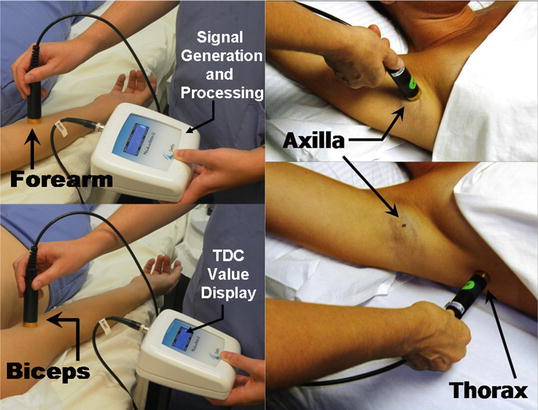
Fig. 13.2
Measuring TDC at multiple sites. Probes can be used to measure TDC at virtually any anatomical site of interest. Here is shown measurements using a probe measuring to an effective depth of 1.5 mm at forearm, biceps, axilla, and lateral thorax. Measurement activates when skin is touched and takes about 10 s
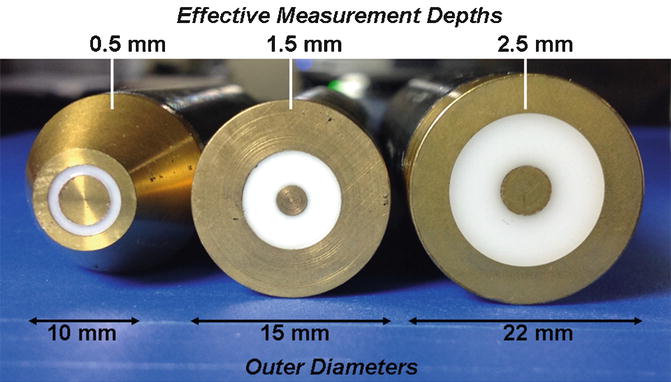
Fig. 13.3
Variation in probe design determines effective measurement depth. TDC measurements are used to assess localized tissue water and its change with the wider probe penetrating more deeply. Choice of probe to use depends on application and available space for placing the probe. The largest effective measurement depth is 5 mm achievable with a probe that has a diameter of 55 mm
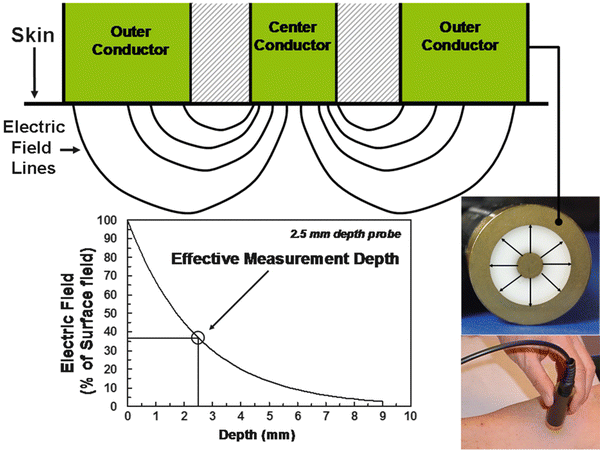
Fig. 13.4
Effective measurement depth concept. Effective measurement depth is defined as that depth at which the electric field produced by the probe on the skin surface is reduced to 1/e (36.7 %) of its value. The electric field lines are schematically illustrated emanating from and then terminating on the concentric electrodes of the probe
Dielectric constant, also known as relative permittivity, is a dimensionless number equal to the ratio of the permittivity of tissue to the permittivity of vacuum. Because TDC values in part depend on tissue water content, TDC values and their change provide indices of water content and quantitative estimates of water content changes. For reference the dielectric constant of distilled water at 32 °C is about 76. Because the measuring devices operate at a frequency of 300 MHz the measured skin TDC values are sensitive to both free and bound water within the measurement volumes. The vertical dimension for the measurement volume ranges between 0.5 mm and 5.0 mm below the epidermis with the total volume depending on the probe diameter.
Currently available devices come in two flavors. One is the original MMD, the multi-probe version with four separate probes as shown in Fig. 13.1 for effective measurement depths of 0.5, 1.5, 2.5, and 5.0 mm with the largest size probe measuring the deepest. The other device (Fig. 13.5) is a compact version (MMDC) in which the sensor and processing electronics are built into the handheld unit. The MMDC has a bar indicator showing the relative amount of contact pressure being exerted on the skin. The MMD and to a lesser extent the MMDC have been used in basic and clinical research studies in which skin tissue water and its change were of interest. Because either probe system can be used in virtually any anatomical location, data and findings are available for multiple anatomical sites on the upper body including face [1, 2], breast [3], forearm [4–7], biceps, axilla, and thorax [8] and on the leg and foot [1, 9, 10]. One of the most frequent uses to date has been for tracking and possible early detection of subclinical lymphedema in women at-risk for or already having lower extremity lymphedema or upper extremity breast cancer treatment-related lymphedema (BCRL) [11–17]. The method also may have value in differentiating lower extremity lymphedema from lipedema [18], characterizing changes in postsurgical fluid status [19], and assessing skin irradiation effects [3].
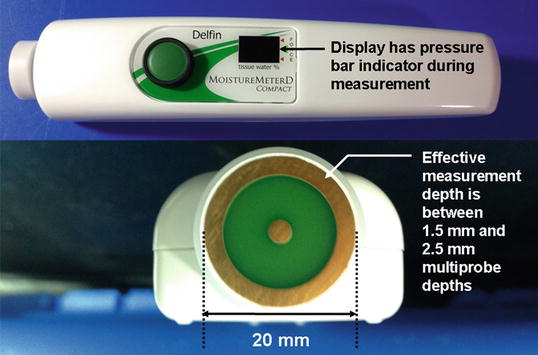

Fig. 13.5
Compact Tissue Dielectric Constant (TDC) measurement device. All functions are built into the single handheld device. Its effective measurement depth is between that of the 1.5 mm and 2.5 mm depth multiprobes and TDC readings would be about 6 % greater than those of the 2.5 mm probe. The display contains a series of horizontal bars that when aligned indicate the proper applied pressure. The display reads out in percent water rather than TDC values directly
Measurement Principles
The control unit (Fig. 13.1) generates and transmits a very low power 300 MHz signal into the probe that is in contact with the skin (Fig. 13.2). The signal is transmitted into the tissue via the probe that acts as an open-ended coaxial transmission line [20]. Part of the signal is absorbed by the tissue, mainly by water, and part is reflected back to the control unit where the complex reflection coefficient is determined [21, 22] from which the dielectric constant is determined [23, 24]. Reflections from the end of this coaxial transmission line depend on the complex permittivity of the tissue which depends on the signal frequency and on the dielectric constant (the real part of the complex permittivity) and the conductivity of the tissue with which the probe is in contact. At 300 MHz the contribution of the conductivity to the overall value of the permittivity is small and the dielectric constant is mainly determined by water molecules (free and bound). Consequently, the device includes and analyzes only the dielectric constant (TDC) that is directly proportional to tissue water content in a manner close to that predicted by Maxwell mixture theory for low water content but a slightly less good prediction for high water content tissues [25]. In all cases TDC is strongly dependent on relative water content with TDC values that decrease with water reductions during hemodialysis [26] and that correlate with whole body water percentages as illustrated in Fig. 13.6 in which forearm TDC values are seen to highly correlate with total body water percentage as determined using bioimpedance measures.
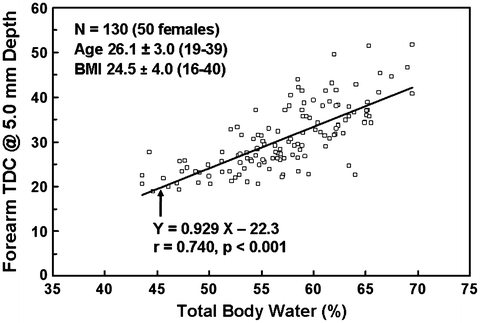

Fig. 13.6
Tissue Dielectric Constant (TDC) values in relation to total body water. TDC values are directly related to percentage of total body water (TBW). TBW was measured via bioimpedance. Relationship between TDC and TBW is illustrated for a 5 mm TDC forearm measurement depth in 130 young adults. The solid line is the linear regression equation with parameters as indicated in the figure
The induced electric field within the tissue falls off exponentially and the effective measurement depth, defined as that depth at which the field is 1/e its surface value, depends on the dimensions of the probe [27] with larger dimensions being associated with deeper penetration. If the tissue measurement volume is viewed as being comprised of two layers, one being the skin including stratum corneum, epidermis and dermis with combined skin depth δ, and the other part being the subcutaneous tissue including fat, then it can be shown that measured TDC values depend on dielectric constants of skin (ε skin) and fat (ε fat) and on δ [3, 27]. This relationship can be expressed [2] as  in which q is a device constant that depends on probe dimensions and is about 0.82 for the 1.5 mm depth probe. Changes in TDC values largely reflect changes in skin water content because of the normally large fraction of skin water. However, because TDC values also depend on skin thickness (δ) comparisons of absolute water content between individuals or groups should be done with caution. An equation linking percentage of tissue water content (PWC%) to TDC values has been proposed [26] for high water content tissues and is given by PWC% = 100 (TDC − 1)/77.5. The denominator of this equation (77.5) is based on a TDC value for water of about 78.5 at 25 °C. However, since water’s dielectric constant depends on temperature, the tissue temperature being measured should be taken into account. For example, at a skin temperature of 34 °C, water’s dielectric constant is about 75.2. Table 13.1 lists water dielectric constants for various temperatures. Temperature corrections may result in small TDC changes but under certain circumstances such corrections are useful and easily done. For example if a PWC% reading on the compact device was 36 % at a tissue temperature of 34 °C then the true percent water in this tissue would be closer to (77.5/74.2) × 36 % = 37.6 %, a value that is approximately 4.4 % greater.
in which q is a device constant that depends on probe dimensions and is about 0.82 for the 1.5 mm depth probe. Changes in TDC values largely reflect changes in skin water content because of the normally large fraction of skin water. However, because TDC values also depend on skin thickness (δ) comparisons of absolute water content between individuals or groups should be done with caution. An equation linking percentage of tissue water content (PWC%) to TDC values has been proposed [26] for high water content tissues and is given by PWC% = 100 (TDC − 1)/77.5. The denominator of this equation (77.5) is based on a TDC value for water of about 78.5 at 25 °C. However, since water’s dielectric constant depends on temperature, the tissue temperature being measured should be taken into account. For example, at a skin temperature of 34 °C, water’s dielectric constant is about 75.2. Table 13.1 lists water dielectric constants for various temperatures. Temperature corrections may result in small TDC changes but under certain circumstances such corrections are useful and easily done. For example if a PWC% reading on the compact device was 36 % at a tissue temperature of 34 °C then the true percent water in this tissue would be closer to (77.5/74.2) × 36 % = 37.6 %, a value that is approximately 4.4 % greater.
 in which q is a device constant that depends on probe dimensions and is about 0.82 for the 1.5 mm depth probe. Changes in TDC values largely reflect changes in skin water content because of the normally large fraction of skin water. However, because TDC values also depend on skin thickness (δ) comparisons of absolute water content between individuals or groups should be done with caution. An equation linking percentage of tissue water content (PWC%) to TDC values has been proposed [26] for high water content tissues and is given by PWC% = 100 (TDC − 1)/77.5. The denominator of this equation (77.5) is based on a TDC value for water of about 78.5 at 25 °C. However, since water’s dielectric constant depends on temperature, the tissue temperature being measured should be taken into account. For example, at a skin temperature of 34 °C, water’s dielectric constant is about 75.2. Table 13.1 lists water dielectric constants for various temperatures. Temperature corrections may result in small TDC changes but under certain circumstances such corrections are useful and easily done. For example if a PWC% reading on the compact device was 36 % at a tissue temperature of 34 °C then the true percent water in this tissue would be closer to (77.5/74.2) × 36 % = 37.6 %, a value that is approximately 4.4 % greater.
in which q is a device constant that depends on probe dimensions and is about 0.82 for the 1.5 mm depth probe. Changes in TDC values largely reflect changes in skin water content because of the normally large fraction of skin water. However, because TDC values also depend on skin thickness (δ) comparisons of absolute water content between individuals or groups should be done with caution. An equation linking percentage of tissue water content (PWC%) to TDC values has been proposed [26] for high water content tissues and is given by PWC% = 100 (TDC − 1)/77.5. The denominator of this equation (77.5) is based on a TDC value for water of about 78.5 at 25 °C. However, since water’s dielectric constant depends on temperature, the tissue temperature being measured should be taken into account. For example, at a skin temperature of 34 °C, water’s dielectric constant is about 75.2. Table 13.1 lists water dielectric constants for various temperatures. Temperature corrections may result in small TDC changes but under certain circumstances such corrections are useful and easily done. For example if a PWC% reading on the compact device was 36 % at a tissue temperature of 34 °C then the true percent water in this tissue would be closer to (77.5/74.2) × 36 % = 37.6 %, a value that is approximately 4.4 % greater.Table 13.1
Dielectric constant of water versus temperature
Temperature (°C) | Dielectric constant |
|---|---|
20 | 80.1 |
23 | 79.0 |
25 | 78.5 |
26 | 78.0 |
28 | 77.3 |
30 | 76.6 |
32 | 75.9 |
34 | 75.2 |
35 | 74.9 |
37 | 74.2 |
40 | 73.2 |
Calibration Procedures
Each device is pre-calibrated by the manufacturer. For the multi-probe system each probe is separately calibrated for a given control unit. If two or more systems are being used, probes should not be interchanged between control units. There may be circumstances when independent calibrations or calibration checks are useful. This can be done by exposing the probe tips to various ethanol–water concentrations and comparing values obtained with known solution dielectric constants. The static dielectric constant for ethanol at 25 °C, averaged from multiple sources, is 24.8. The approximate dielectric constant values for various ethanol–water mixtures that are listed in Table 13.2 may be used to compare values obtained with any probe and if needed take appropriate calibration adjustments into account. An example of a full calibration curve is shown in Fig. 13.7, but only a few ethanol–water mixture concentrations would be sufficient.
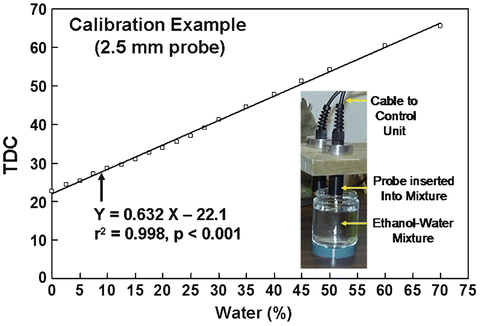
Table 13.2
Ethanol–water mixture dielectric constant at 25 °C
% Ethanol by volume | Dielectric constant of ethanol–water mixture |
|---|---|
0 | 78.3 |
10 | 73.0 |
20 | 67.6 |
30 | 62.3 |
40 | 56.9 |
50 | 51.6 |
60 | 46.2 |
70 | 40.9 |
80 | 35.5 |
90 | 30.2 |
100 | 24.8 |

Fig. 13.7
Tissue Dielectric Constant (TDC) probe calibration check using various alcohol-water concentrations. Each probe is calibrated by exposing the probe measuring head to varying ethanol–water concentrations. This figure is for a 2.5 mm effective measurement depth probe and illustrates the essentially linear dependence of the TDC value with water concentration (%Water)
Measurement Procedure
Touching skin with one of the probes of the multiprobe device or touching it with the compact device activates the measurement that is heralded by short distinctive sound. A single measurement takes about 10 s or less to complete with completion signaled by another distinct audible sound. The TDC value is displayed on the control unit of the multiprobe readout. For the compact device the readout is not directly that of the TDC value, but instead it is a calculated percentage water PCW% determined via the equation previously given. If one is using both multiprobe and compact devices, it is useful to convert compact readings to TDC to achieve uniformity of measures for comparison purposes between results obtained from the two systems. The conversion equation that can be used is TDC = 1 + [(PWC%) (ε water − 1)]/100 in which PWC% is the number displayed on the compact probe (calculated percentage water) and ε water is the dielectric constant of water used by the device for its calculation which is 78.5. For example, a reading of 36 % would correspond to a TDC value of 1 + (36 × 77.5)/100 = 28.9.
Short- and Long-Term Measurement Repeatability
One or Multiple Measurements Averaged
TDC measurements taken in triplicate and averaged are the method most frequently employed. However, it has been shown that for TDC measurements on forearms of healthy women and women with BCRL the average difference in TDC value between the first measurement and the average of three sequential measurements to a depth of 2.5 mm is less than ± 1 TDC unit [6]. This suggests that for many purposes a single measurement may be sufficient; however, similar data on other anatomic sites is not yet available.
Short-Term Intrarater and Interrater Repeatability
Because some applications use pre- and post-TDC measurements to assess single treatment therapeutic modalities [11, 15] the measurement repeatability over intervals of the order of 60 min are of interest. Intrarater reliability has been assessed based on bilateral forearm TDC measurements to 2.5 mm depth on five subjects at 0, 30, and 60 min by a person with familiarity with TDC measurements. Intrarater repeatability has been assessed using intraclass correlation coefficients (ICC) that broadly express the percentage of variability attributable to true subject variance as opposed to measurement related variability (between-subject variation/total variation). Results revealed a single measure ICC value (ICC2,1) of 0.996 with a 95 % confidence interval of 0.96–1.000. Additional tests based on measurements of a minimally trained rater under the same circumstances yielded ICC2,1 values 0.999 with 95 % confidence intervals of 0.994–1.000. Interrater reliability (ICC2,2) has also been assessed via triplicate measurements made on four subjects at 30 min intervals by two medical students who were minimally trained in TDC measurements. ICC2,2 values obtained were quite good at 0.997 with a 95 % confidence interval of 0.988–0.999. Assessments of interrater reliability of TDC measurements made 1 week apart by two other minimally trained medical students yielded reasonable ICC values for both the 2.5 mm and the 1.5 mm depth probes as summarized in Table 13.3 for forearm, leg, and foot. Interobsever agreement of absolute TDC measurements in lower extremities has also been assessed based on measurements of three minimally trained measurers who each measured TDC at calf, ankle, and foot to a depth of 2.5 mm in 34 healthy women [10]. Results showed average ICC2,3 values for ankle and calf at excellent levels of 0.94 at both ankle and calf but a lesser value of 0.77 for the foot.
Table 13.3
Intraclass correlation coefficients (ICC) for Tissue Dielectric Constant (TDC) measurements
Measurement site | ICC | 95 % Confidence interval |
|---|---|---|
Forearm | ||
2.5 mm depth | 0.962 | (0.852–0.994) |
1.5 mm depth | 0.793 | (0.394–0.994) |
Leg | ||
2.5 mm depth | 0.945 | (0.792–0.991) |
1.5 mm depth | 0.941 | (0.778–0.991) |
Foot | ||
2.5 mm depth | 0.887 | (0.615–0.982) |
1.5 mm depth | 0.923 | (0.720–0.988) |
Long-Term Reliability
Longer term intrarater repeatability has been assessed by measurements of normal control arms in 32 women on six separate occasions by the same therapist over a 24 month period. These women had been diagnosed with unilateral breast cancer and their contralateral arms measured prior to surgery and then at 3, 6, 12, 18, and 24 months post-surgery. Intraclass correlation coefficients (ICC2,1) determined for forearm TDC measurements to a depth of 2.5 mm was 0.900 with a 95 % confidence interval of 0.835–0.946.
Factors Effecting Measured TDC Values
Effective Measurement Depth
Depending on the anatomical site, measured TDC values will vary with generally higher values at lesser depths and lesser values at greater depths. This dependence is not necessarily linear as illustrated by measurements made on the anterior forearm of a large group of women (Fig. 13.8). For this data set the TDC averaged between both arms decreased according to a nonlinear power regression equation given by TDC = 32.44 δ −0.185 in which δ is measurement depth. This observed pattern is at least in part due to the inclusion of increasing amounts of low water content fat in the measurement volume with increasing depth [8]. Although this pattern is commonly observed in tissues such as forearm and biceps it may be different in other anatomical sites. For example no significant difference in TDC values was detected among depths of 0.5, 1.5, and 2.5 mm on the cheek or the dorsum of hand or foot [1]. Contrastingly, significant differences in TDC values as a function effective measurement depth were observed for forehead; forearm; and medial, lateral, and anterior gaiter areas of the leg [1].
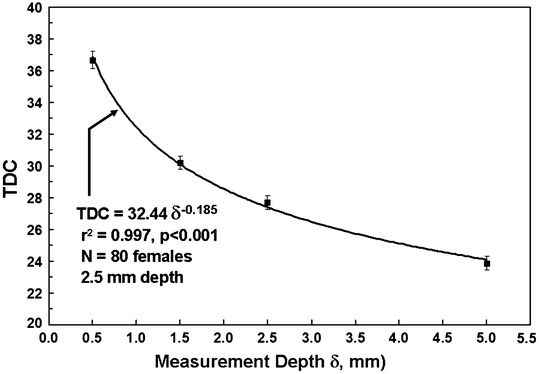
Get Clinical Tree app for offline access

Fig. 13.8
Tissue Dielectric Constant (TDC) measurement depth-dependence: pre-surgery. Data points are pre-surgery mean TDC values for 80 patients with individual patient TDC values calculated as the average of both forearms. Error bars are ± 1 sem. Solid line




Stay updated, free articles. Join our Telegram channel

Full access? Get Clinical Tree







